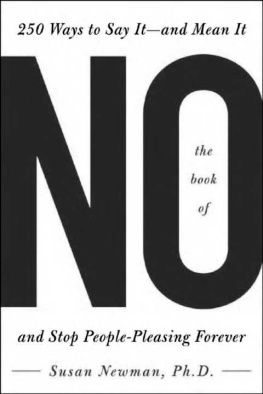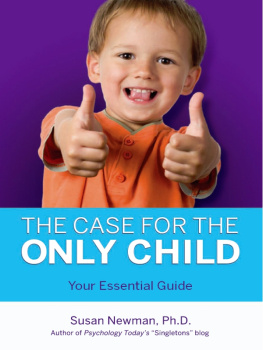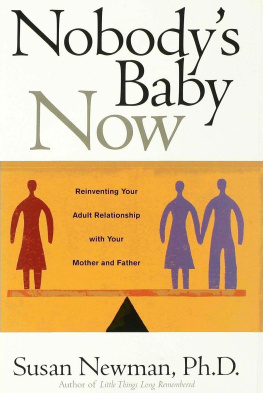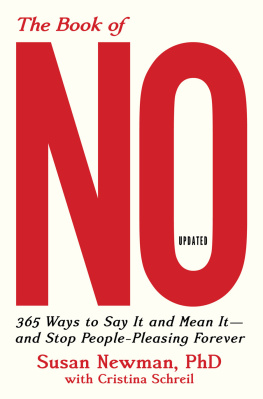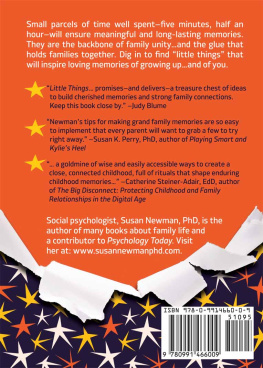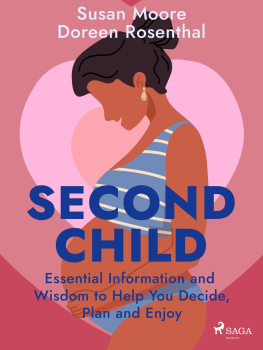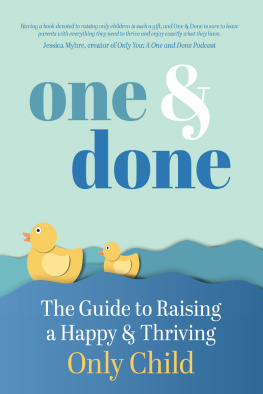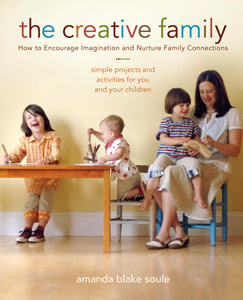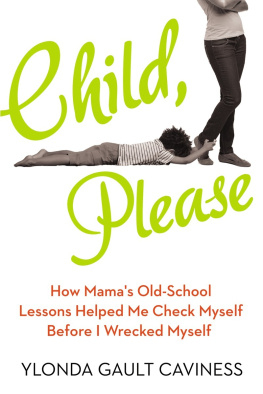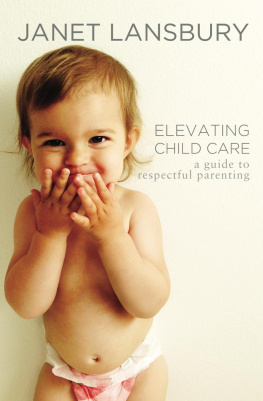Susan Newman - Parenting an Only Child: The Joys and Challenges of Raising Your One and Only
Here you can read online Susan Newman - Parenting an Only Child: The Joys and Challenges of Raising Your One and Only full text of the book (entire story) in english for free. Download pdf and epub, get meaning, cover and reviews about this ebook. year: 2001, publisher: Harmony/Rodale, genre: Children. Description of the work, (preface) as well as reviews are available. Best literature library LitArk.com created for fans of good reading and offers a wide selection of genres:
Romance novel
Science fiction
Adventure
Detective
Science
History
Home and family
Prose
Art
Politics
Computer
Non-fiction
Religion
Business
Children
Humor
Choose a favorite category and find really read worthwhile books. Enjoy immersion in the world of imagination, feel the emotions of the characters or learn something new for yourself, make an fascinating discovery.

- Book:Parenting an Only Child: The Joys and Challenges of Raising Your One and Only
- Author:
- Publisher:Harmony/Rodale
- Genre:
- Year:2001
- Rating:4 / 5
- Favourites:Add to favourites
- Your mark:
- 80
- 1
- 2
- 3
- 4
- 5
Parenting an Only Child: The Joys and Challenges of Raising Your One and Only: summary, description and annotation
We offer to read an annotation, description, summary or preface (depends on what the author of the book "Parenting an Only Child: The Joys and Challenges of Raising Your One and Only" wrote himself). If you haven't found the necessary information about the book — write in the comments, we will try to find it.
Parenting an Only Child: The Joys and Challenges of Raising Your One and Only — read online for free the complete book (whole text) full work
Below is the text of the book, divided by pages. System saving the place of the last page read, allows you to conveniently read the book "Parenting an Only Child: The Joys and Challenges of Raising Your One and Only" online for free, without having to search again every time where you left off. Put a bookmark, and you can go to the page where you finished reading at any time.
Font size:
Interval:
Bookmark:
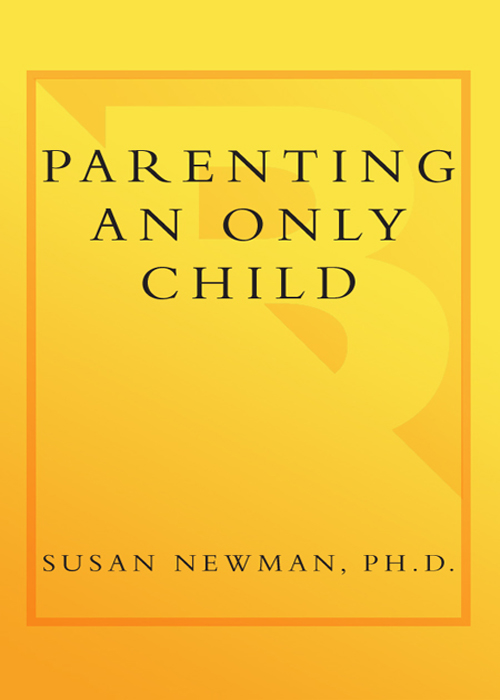
ALSO BY SUSAN NEWMAN, PH.D.
Little Things Long Remembered: Making Your Children
Feel Special Every Day
Little Things Mean a Lot: Creating Happy Memories with
Your Grandchildren
Little Things Shared: Lasting Connections
Between Family and Friends
Getting Your Child into College:
What Parents Must Know
Lets Always... Promises to Make Love Last
Never Say Yes to a Stranger: What Your
Child Must Know to Stay Safe
You Can Say No to a Drink or a Drug:
What Every Kid Should Know
It Wont Happen to Me: True Stories of
Teen Alcohol and Drug Abuse
Dont Be S.A.D.: A Teenage Guide to
Stress, Anxiety & Depression
Memorable Birthdays: Now a Guide... Later a Gift
ABOUT THE AUTHOR
Social psychologist Susan Newman, Ph.D., an authority on only children and herself the mother of an only child, specializes in issues that affect children and family life. She teaches at Rutgers University in New Jersey and is the author of eleven books including the bestselling Little Things Long Remembered: Making Your Children Feel Special Every Day, Little Things Mean A Lot: Creating Happy Memories with Your Grandchildren, and Never Say Yes to a Stranger. Parenting an Only Child has been featured on NBC Nightly News, CNN, ABC, and Fox News, as well as in the New York Times, the Los Angeles Times, USA Today, and the Boston Globe. Several of her books have also become award-winning educational videos. Newman is often a featured speaker and workshop leader on parenting topics. Visit her web site at: www.susannewmanphd.com
The New Traditional Family
Is it a factor of economic restraints, more complex lives, increased infertility, pure good sense, or something else that is changing the makeup of the family unit?
When you were growing up, you probably knew or knew of a family with four or five, even eight, children. In those days, raising a station wagonsize family neither attracted attention nor caused alarm. But mention a family with five or six children today and someone is certain to groan, How do they do it? Why do they do it? There must be a better way. There seems to be.
Never before have there been so many choices in family type or size. Our ever-evolving definition of family is broadening and diversifying to encompass blended families, biracial families, homosexual-parent families, and single-parent families. Even though family policy and laws are slow in catching up to current lifestyles, different choices are widely accepted, especially those revolving around single, or gay and lesbian parenting and adoption. Families are getting smaller and the only-child option is becoming increasingly popular.
The preference for smaller families is evident. In 1972, 56 percent of those asked in a large national opinion study thought that three or more children were ideal; in a similar study done in 1998 that percentage had dropped to 39. Although both men and women may still state a preference for two or three children, the number of women who have one child mounts steadily.
According to the U.S. Census Bureau, in 1972 there were between 8 and 9 million only children. By 1985 the number had grown to 13 million, and by the beginning of the new millennium it approached the 16 million mark, confirming psychologist Sandra Scarrs claim in the mid-eighties that many serious parents... are planning to invest their best efforts in one or at the most two children.
Those who study demographics agree that the one-child household is the fastest-growing family unit. It surprises many people to learn that one-child families outnumber families with two children and have for more than a decade. Fertility rates in many places are dropping rapidly, especially in the richest countries, where, to put it simply, any two people are not producing two more people. There are a number of explanations for this trend. People marry later, leaving them fewer childbearing years and a greater chance of facing infertility or secondary infertility; more and more people opt to have and raise a child as single parents and one is realistically all they can handle; one out of almost every two marriages ends in divorce, often before a second child is considered or born, and predictions are that divorce rates will not change much in the foreseeable future.
But probably one of the greatest influences on the changing family is the influx of women into the workforce. Over 77 percent of women with children work, many with young children. By 1998, 67 percent of parents both held jobs outside the home. Beyond the stresses of working, many feel a second child is more of a financial strain than they can, or want to, undertake.
Long gone is what we once called the typical or average family that was made up of two children, a father who worked, and a mother who stayed home to raise her children. Today, that family as we knew it, of Ozzie and Harriet fame, makes up barely 3 percent of American families. Whether women work outside the home or devote themselves to their families full-time, the family is smaller. Over one-fifthand climbingof all families with children has one child. Between 1980 and 1990, there was an increase of 76 percent in the number of women ages forty to forty-four with one child, who, because of their ages, were unlikely to bear a second. If changes in childbearing patterns and family styles continue, which they are more than likely to do, its safe to predict that more and more families will have one child.
The Way It Was
Forty, thirty, or even twenty years ago an only child was not the desired lot. Although there were exceptions, in most cases if a couple had an only child, something had intervened to prevent them from adding to their family.
What we view as normal in the childbearing arena has a lot to do with what was considered normal as we were growing up. Decisions about how many children to have are equally affected by what is accepted at the time we are deciding. I had two children because at the time [thirty years ago] it was the American thing to do, explains Betty Plumlee.
Susan Leites talks about the childbearing milieu thirty years ago. Many women admitted they were afraid to take care of themselves. They married and had the obligatory two or three children whether or not they wanted them. It was the right thing to do. Having one was easy for me because I was a painter committed to my career. I had rebelled anyway; I didnt feel constrained to follow the norm. I dont think the number of children a woman had then corresponded to how she felt about having children. Women followed the conventions of the time.
Says Jamie Laughridge, a former editor of Womans Day Specials: Bridal Magazine, It was so much easier for our grandparents and parents. They didnt know what we know or have the career opportunities we have. Womens lives were mapped out: You fell in love, got married, had children. No concern over options or how many children to have. No fears of being trapped in the house or of losing your job if you took too many or too lengthy maternity leaves because mothers werent supposed to have jobs. It seems women may have been better off. We simply know too much.
In the past there were many reasons why people felt the need to have more than one child. For one thing, children were more isolated. Parents feared the spread of disease. A child with strep throat or chicken pox stayed home for two or three weeks. Swimming in public pools was avoided during the polio scare.
Today children are immunized against most childhood diseases and given antibiotics for the less serious illnesses. Usually they return to school and their normal routines within days. The absence of health isolation was one of the factors that made me feel having only one was okay, admits Susan Leites.
Next pageFont size:
Interval:
Bookmark:
Similar books «Parenting an Only Child: The Joys and Challenges of Raising Your One and Only»
Look at similar books to Parenting an Only Child: The Joys and Challenges of Raising Your One and Only. We have selected literature similar in name and meaning in the hope of providing readers with more options to find new, interesting, not yet read works.
Discussion, reviews of the book Parenting an Only Child: The Joys and Challenges of Raising Your One and Only and just readers' own opinions. Leave your comments, write what you think about the work, its meaning or the main characters. Specify what exactly you liked and what you didn't like, and why you think so.

